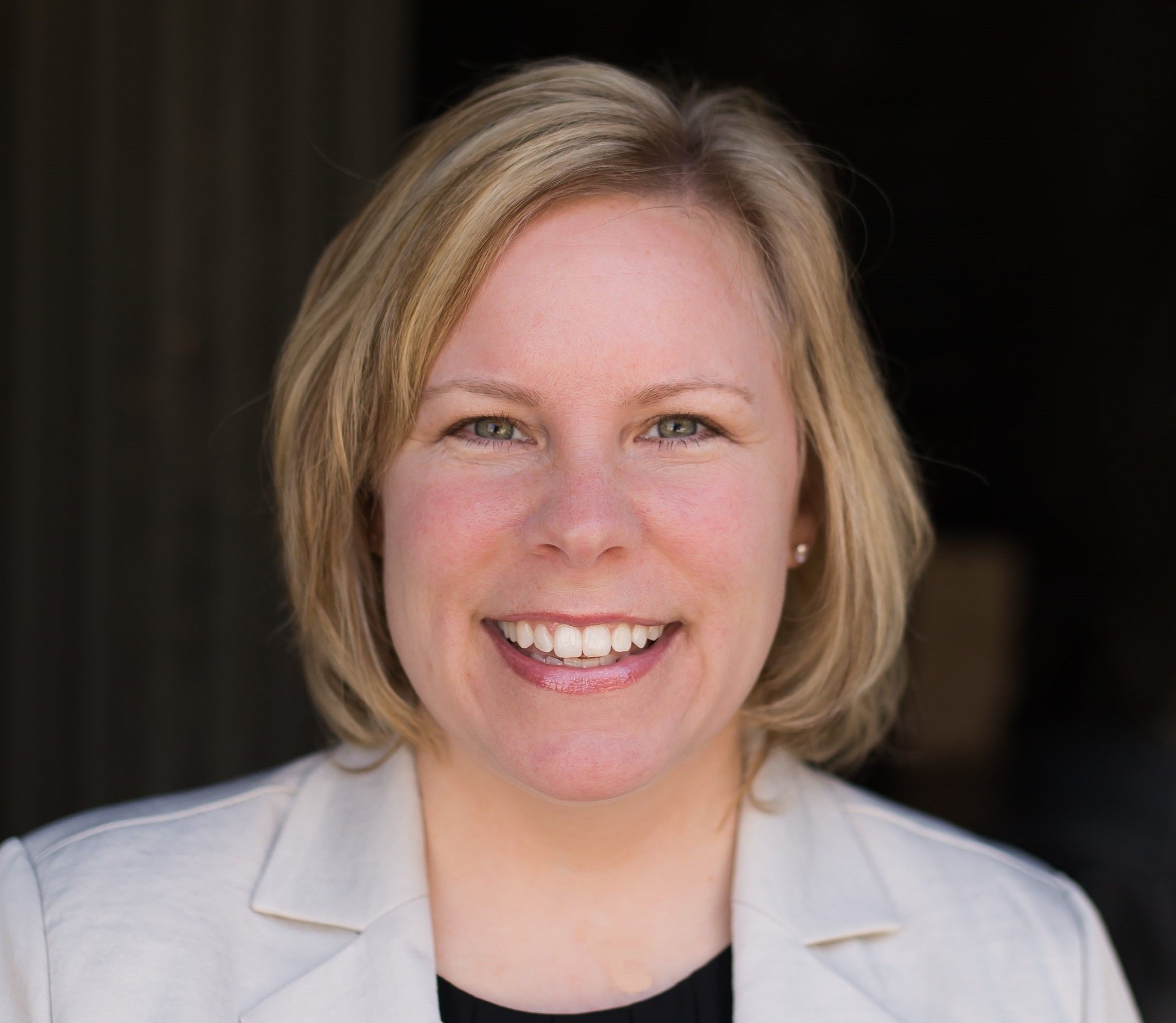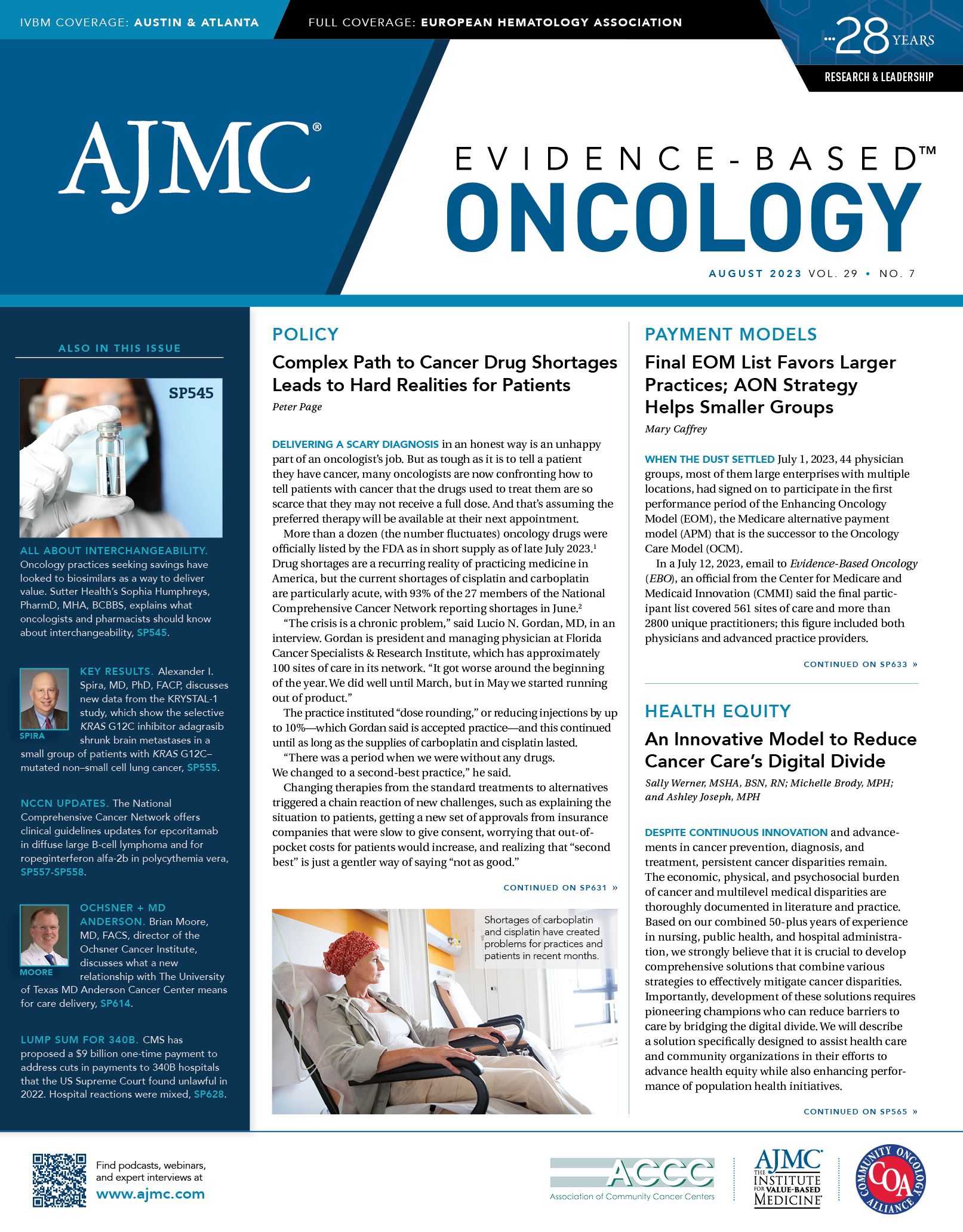- Center on Health Equity & Access
- Clinical
- Health Care Cost
- Health Care Delivery
- Insurance
- Policy
- Technology
- Value-Based Care
An Innovative Model to Reduce Cancer Care’s Digital Divide
https://doi.org/10.37765/ajmc.2023.89420
Despite continuous innovation and advancements in cancer prevention, diagnosis, and treatment, persistent cancer disparities remain. The economic, physical, and psychosocial burden of cancer and multilevel medical disparities are thoroughly documented in literature and practice. Based on our combined 50-plus years of experience in nursing, public health, and hospital administration, we strongly believe that it is crucial to develop comprehensive solutions that combine various strategies to effectively mitigate cancer disparities. Importantly, development of these solutions requires pioneering champions who can reduce barriers to care by bridging the digital divide. We will describe a solution specifically designed to assist health care and community organizations in their efforts to advance health equity while also enhancing performance of population health initiatives.
Cancer Disparities Among the Medically Underserved
Statistics gathered by the National Cancer Institute (NCI) are alarming.1 Some examples include as follows:
- Cancer rates for Black/African American individuals have declined over time, but they remain higher than those in other racial and ethnic groups for many cancer types.2
- Incidence rates of colorectal, lung, and cervical cancers are much higher in rural Appalachia than in urban areas in the region.3
- Rates of kidney cancer are higher for American Indian/Alaska Native individuals than any other racial/ethnic group in the United States.4
Medically underserved communities in the United States have endured a long history of disparate access to quality cancer care and long lacked culturally appropriate supportive care services. The NCI notes that certain groups experience cancer disparities due to a higher likelihood of
Werner

Brody

Joseph

encountering barriers to access; these barriers have been cited in studies.1,5,6 For example, individuals with low incomes, low health literacy, long distances to screening sites, and lack of transportation are less likely to have recommended cancer screening tests and to be treated according to guidelines than those who don’t encounter these obstacles.
Making Access to Cancer Care More Equitable
Rooted in the belief that inequitable access to quality, comprehensive, and affordable cancer care constitutes a public health crisis, 2 organizations have developed an innovative digital model to ensure individuals in medically underresourced communities can readily access cancer support services. The model came about via collaboration between the nonprofit Cancer Support Community (CSC) and Equiva Health, a health engagement platform provider.
Delivering more than $50 million in free services each year, CSC has decades of experience providing evidence-based psychosocial support services to uplift and strengthen individuals impacted by cancer. For more than 11 years, Equiva has pioneered innovations in patient experience and health engagement, providing support for numerous initiatives across leading health care organizations. These initiatives aim to advance health equity, improve population health, enhance health outcomes, and drive institutional financial success.
Improving Access to Psychosocial Care: A Novel Approach
In 2022, the organizations conceived a novel approach to improve access to psychosocial oncology care and supportive oncology services by bringing CSC resources to targeted in-need populations in their homes via broadband-enabled tablet devices. Using Equiva’s health relationship management platform,7 CSC can coalesce any number of offerings, such as virtual cancer support groups, healthy lifestyle classes, and cancer educational content, into a single, easy-to-navigate tablet interface. Multilanguage capabilities are available, and interfaces can be configured to support specific populations to address an array of needs across medically underserved individuals in both rural and urban settings.
The objective is to offer a user-friendly device that ensures important services are easily accessible at any time and from any location. Pilot programs were recently launched at CSC network partner sites, including Gilda’s Club Twin Cities8 in Minnesota, CSC San Francisco Bay Area in California, and CSC at Breckinridge Health in Kentucky. Each pilot site focuses on specific populations in their service areas, eg, rural communities in Breckinridge County. Soon to launch are CSC Los Angeles in California, dedicated to primarily serve Spanish-speaking populations, and CSC Arizona, with expected participation from Spanish-speaking populations as well as members of the Hopi Nation and the Navajo Nation.9
The Affordable Connectivity Program: A Bridge to Improving Health Access
In a guide published by the US Department of Health and Human Services, authors state that “in the instance of the lack of health care technologies, inadequate broadband infrastructure is a critical barrier to provision of telehealth services and remote learning (especially) in rural areas, (and) particularly for approaches that involve synchronous video communication between provider and recipient.”10
A key component of this model includes efforts to make members of the public, health care providers, and community organizations aware of the Federal Communication Commission’s (FCC) $14.2 billion Affordable Connectivity Program (ACP)11 and to serve as a conduit to enrolling eligible participants via Equiva’s ACP-approved broadband partner.
Launched in 2021, the ACP provides eligible households with discounted broadband services. A household is eligible if at least one individual living in the home is enrolled in a federal subsidy program such as WIC (Special Supplemental Nutrition Program for Women, Infants, and Children), Medicaid and many others. The ACP also provides discounts toward the purchase of computing devices, including tablets. Equiva enables CSC not only to preload tablets with education and support resources, but also to distribute these broadband-enabled tablets to enrolled households via US mail or to be picked up in person at CSC network partner sites.
For individuals who receive assistance with ACP enrollment, CSC pilot sites extend their engagement by using the CMS Health Related Social Needs Screening Tool12 (which is built into CSC’s platform) and CSC’s proprietary CancerSupportSource,13 the first validated distress screening program developed for community-based hospitals, physician practices, and advocacy groups. With these tools, coordinators can ascertain what level of support is needed, align referrals to appropriate resources and programs, and arrange timely outreach based on each individual’s specific needs.
Equiva provides a comprehensive toolkit that helps each CSC site run its program, including offering templated outreach materials. Pilot sites work with Equiva to create their individualized tablet layouts and to customize promotional approaches based on their marketing to the public, providers and community organizations.
Using surveys and data analytics, Equiva and CSC monitor tablet usage to capture user input and identify the most widely accessed content and services. These data will help guide future decisions about interface design and program offerings and will inform expansion to other populations.
Removing Broadband Barriers
Authors from the Center on Poverty and Social Policy at Columbia University wrote, “Broadband connectivity is vital for work, school, health care, and living in the 21st century, yet is out of reach for millions.”14 Although 48 million households qualify for the ACP, fewer than 16 million enrolled in its first year.15
Many remain unaware of this program, including individuals in health care organizations serving Medicaid enrollees. An estimated 93 million individuals in the US are enrolled in Medicaid.16 This model was developed in response to calls from the FCC and others to develop new approaches to bolster ACP awareness and enrollment.17
Connectivity When Needed Most
For patients and their loved ones, this approach improves engagement by expanding access to resources that can significantly help those impacted by cancer. Tablet users, for example, can readily find details about the CSC’s Cancer Support Helpline. Through the helpline, licensed mental health professionals and specialized resource navigators provide guidance and support, at no cost to patients or caregivers, such as:
- referrals to numerous CSC psychosocial offerings;
- navigation for clinical trials and treatment decision-making;
- navigation to resources for transportation, housing, and medical assistance funds; and
- education about healthy lifestyle choices and connectivity to educational offerings.
Support group referrals are often made to in-person or remote meetings, the latter of which can be accessed via CSC-provided tablets. Research results show that joining a cancer support group can improve both quality of life and survival rates. Individuals involved in support groups often report feeling better, more hopeful, and less lonely.18
Improved Engagement Supports Improved Outcomes
Tablets enable patients to engage and maintain involvement in their care, which helps providers retain patients at follow-up. According to the CDC, a growing body of evidence indicates that individuals with higher patient activation (ie, the knowledge, skills, and confidence to become actively engaged in their health care) have better health outcomes.19
Supportive services have shown to be important to use in conjunction with clinical oncology care. With today’s demands on a shrinking and increasingly burned-out clinical workforce, many providers (especially in rural areas) have limited resources to provide supportive services. Some community oncologists choose to complement their care delivery with referrals to CSC, thereby easing the staffing demands associated with providing psychosocial and health-related social needs.
Reducing Risks, Reducing Costs
For payers, this model supports goals to reduce medical and financial risk. The approach supports initiatives to keep patients adherent to care and to identify when real-time risks and/or barriers exist.
Research shows that patients with cancer who are depressed incur an annual health care cost of at least $100,000 more than their counterparts who are not depressed. A strong cost mitigation strategy for health systems and payers is to incorporate distress screening and health-related social needs screenings. These provide risk alerts and help align timely allocation of targeted interventions to lessen utilization burden for those with both cancer and depression.20
Without connectivity and a device to access cancer resources, individuals may lack important information that can help keep them as healthy as possible during and after treatment. Connectivity can facilitate timely medical consultations, enable engagement via telehealth visits, and increase access to cancer resources, all of which contribute positively to improved health outcomes and overall quality of care.
Cost reductions also can be realized. CSC research results suggest that the use of its distress screener combined with Cancer Support Community proactive navigation and follow-up reduces emergency department visits by 50%.21
Conclusion
Health inequities account for approximately $320 billion in annual health care spending, according to Deloitte, and if unaddressed could surpass $1 trillion by 2040.22 Improved efforts to dismantle health inequities can help ensure individuals have a fair chance to access, afford, and navigate health care resources and services. These efforts also are helping to reduce costs.
We believe all individuals should have an opportunity to achieve the best health outcomes possible, regardless of race, ethnicity, sex, age, sexual orientation, socioeconomic status, or zip code. Models such as the one described in this article help bridge the internet connectivity gap and can be effective in delivering solutions that improve health services and outcomes for communities whose members are disproportionately affected by cancer. Simultaneously, this model supports efforts among providers and payers to increase patient engagement, improve efficiency and quality of care, strengthen cost controls, and reduce both medical and financial risk.
Additional information is available in a position paper titled “Revisiting Population Health With the FCC’s $14.2 Billion Affordable Connectivity Program: What Medicaid Management and Health Equity Executives Should Know.”23
Author Information
Sally Werner, MSHA, BSN, RN, is the chief experience officer for the Cancer Support Community. As a health administrator, she has overseen inpatient and outpatient oncology care, cancer research, cancer registry, supportive services, radiation oncology, navigation, and infusion centers.
Michelle Brody, MPH, leads customer success initiatives at Equiva. She has experience in program management, including recently leading Weill Cornell’s participation in oncology value-based care models such as the Oncology Care Model.
Ashley Joseph, MPH, leads customer success initiatives at Equiva. She has a range of experience in mental health advocacy, hospital operations optimization, organizational change, and strategic initiative implementation.
Author contact information
Sally Werner, MSHA, BSN, RN, swerner@cancersupportcommunity.org
Michelle Brody, MPH, mbrody@equivahealth.com
Ashley Joseph, MPH, ajoseph@equivahealth.com
Financial Disclosures. None
Funding Source. Grant monies are being evaluated with applications to be submitted following pilot program evaluation.
References
1. Cancer disparities. National Cancer Institute. Updated March 28, 2022. Accessed July 8, 2023. https://www.cancer.gov/about-cancer/understanding/disparities
2. Lawrence WR, McGee-Avila JK, Vo JB, et al. Trends in cancer mortality among Black individuals in the US from 1999 to 2019. JAMA Oncol. 2022;8(8):1184-1189. doi:10.1001/jamaoncol.2022.1472
3. Addressing cancer disparities in Appalachia. National Cancer Institute. September 21, 2017. Accessed July 9, 2023. https://www.cancer.gov/research/areas/disparities/electra-paskett-addressing-cancer-disparities-appalachia
4. Cancer stat facts: kidney and renal pelvis cancer. National Cancer Institute. Accessed July 9, 2023. https://seer.cancer.gov/statfacts/html/kidrp.html
5. O’Connor JM, Sedghi T, Dhodapkar M, Kane MJ, Gross CP. Factors associated with cancer disparities among low-, medium, and high-income US counties. JAMA Netw Open. 2018;1(6):e183146. doi:10.1001/jamanetworkopen.2018.3146
6. Raman V, Adam MA, Turner MC, Moore HG, Mantyh CR, Migaly J. Disparity of colon cancer outcomes in rural America: making the case to travel the extra mile. J Gastrointest Surg. 2019;23(11):2285-2293. doi:10.1007/s11605-019-04270-5
7. Beyond patient experience and patient engagement. Equiva. Accessed July 9, 2023. https://equivahealth.com/patient-experience-healthcare-crm-platform/
8. Fox A. Equiva Health, Gilda’s Club, healthcare providers leverage affordable broadband funding. HealthcareITNews. April 13, 2023. Accessed July 9, 2023. https://www.healthcareitnews.com/news/equiva-health-gildas-club-healthcare-providers-leverage-affordable-broadband-funding
9. Equiva advances cancer support community initiatives to help medically underserved communities access cancer support resources. News release. Equiva. June 15, 2023. Accessed July 9, 2023. https://equivahealth.com/2023/06/15/help-communities-access-cancer-resources/
10. Graves JM, Abshire DA, Amiri S, Mackelprang JL. Disparities in technology and broadband internet access across rurality: implications for health and education. Fam Community Health. 2021;44(4):257-265. doi:10.1097/FCH.0000000000000306
11. Affordable Connectivity Program. Federal Communications Commission. Updated May 4, 2023. Accessed July 9, 2023. https://www.fcc.gov/acp
12. A guide to using the Accountable Health Communities Health-Related Social Needs Screening Tool: promising practices and key insights. CMS. Updated August 2022. Accessed July 9, 2023. https://innovation.cms.gov/media/document/ahcm-screeningtool-companion
13. Cancer Support Community and Equiva Health to create new industry standard for digital cancer support. News release. Cancer Support Community. December 5, 2022. Accessed July 9, 2023. https://www.cancersupportcommunity.org/news/csc-and-equiva-health-create-new-industry-standard
14. Understanding the potential reach of the Affordable Connectivity Program. Center on Poverty and Social Policy at Columbia University. May 4, 2022. Accessed July 9, 2023. https://www.povertycenter.columbia.edu/publication/2022/affordable-connectivity-program
15. ACP enrollment and claims tracker. Universal Service Administrative Co. Accessed July 9, 2023. https://bit.ly/43cxTRS
16. March 2023 Medicaid & CHIP enrollment data highlights. Medicaid.gov. Updated April 28, 2023. Accessed July 9, 2023. https://www.medicaid.gov/medicaid/program-information/medicaid-and-chip-enrollment-data/report-highlights/index.html
17. Affordable Connectivity Outreach Grant Program. Federal Communications Commission. Updated July 3, 2023. Accessed July 9, 2023. https://www.fcc.gov/acp-grants
18. Cancer support groups. National Cancer Institute. Updated January 24, 2019. Accessed July 9, 2023. https://www.cancer.gov/about-cancer/coping/adjusting-to-cancer/support-groups#
19. Patient engagement. CDC. August 16, 2021. Accessed July 9, 2023. https://www.cdc.gov/healthliteracy/researchevaluate/patient-engage.html
20. Mausbach BT, Yeung P, Bos T, Irwin SA. Health care costs of depression in patients diagnosed with cancer. Psychooncology. 2018;27(7):1735-1741. doi:10.1002/pon.4716
21. Miller MF, Zaleta AK, Allen ML, Nichols HM, Robinson DC. Impact of distress screening and referral on health care utilization and cost among breast cancer patients: a retrospective cohort study. J Psychosocial Oncol Res Pract. 2022;4(2):p e070. doi:10.1097/OR9.0000000000000070
22. Davis A, Batra N, Dhar A, Bhatt J. US health care can’t afford health inequities. Deloitte Insights. June 22, 2022. Accessed July 9, 2023. https://www2.deloitte.com/us/en/insights/industry/health-care/economic-cost-of-health-disparities.html
23. Revisiting population health with the FCC’s Affordable Connectivity Program. Equiva. Accessed July 9, 2023. https://equivahealth.com/revisiting-population-health-with-the-fccs-affordable-connectivity-program/

